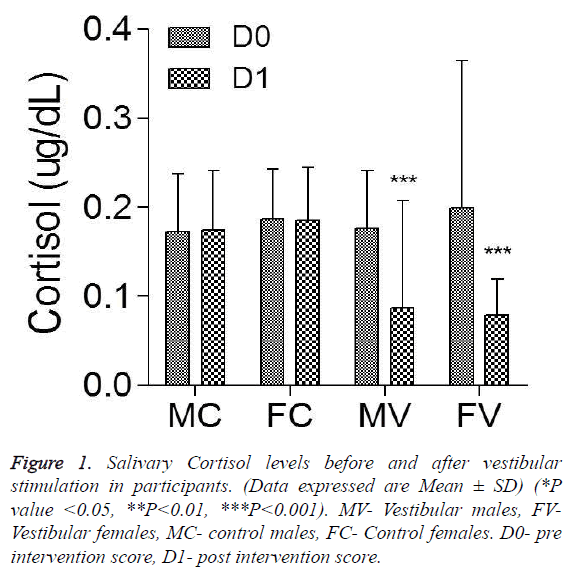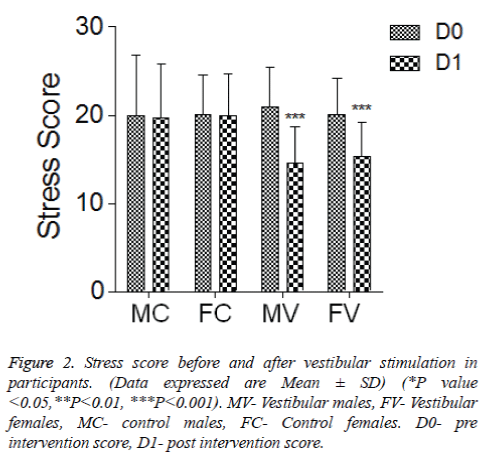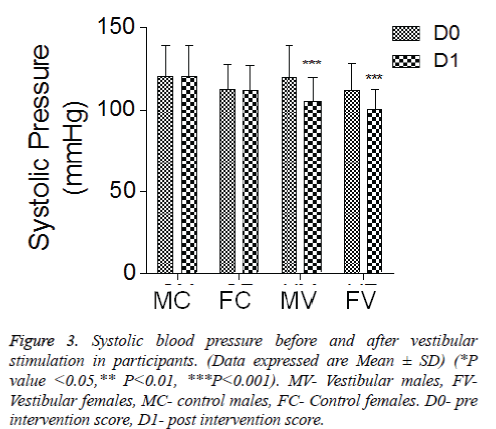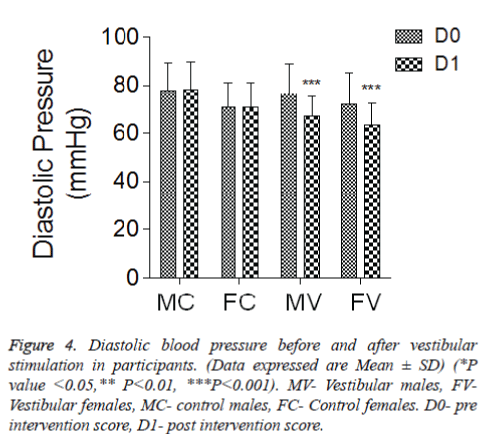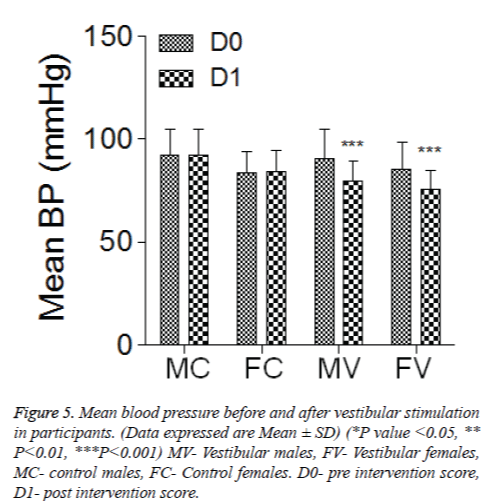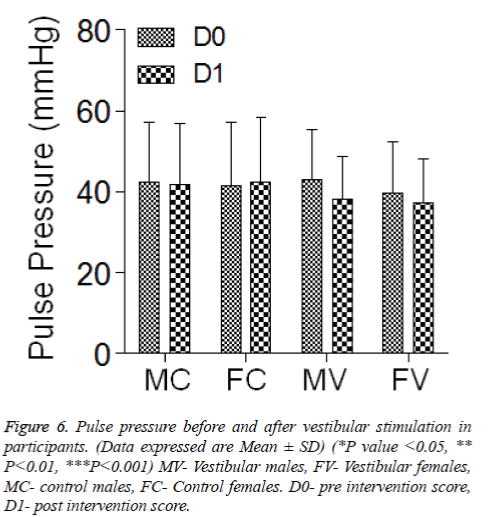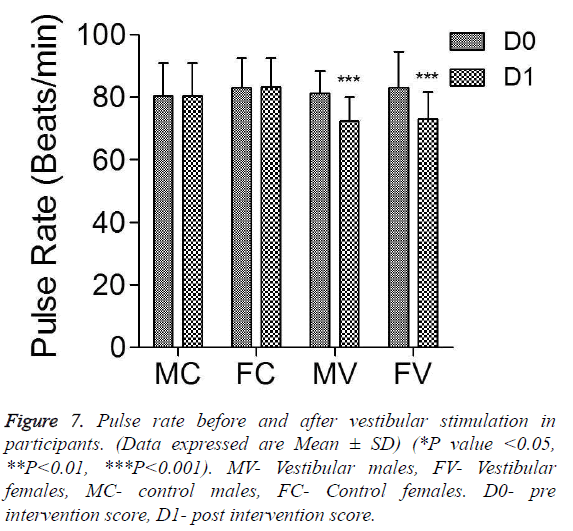- Biomedical Research (2016) Volume 27, Issue 3
Effect of vestibular stimulation on stress and cardiovascular parameters in healthy college students.
Archana R1, Kumar Sai Sailesh2, Mukkadan JK3*
1Department of Physiology, Saveetha Medical College, Saveetha University, Thandalam, Chennai, Tamil Nadu, India
2Department of Physiology, Little Flower Institute of Medical sciences and Research, Angamaly, Kerala, India
3Department of Physiology, Little Flower Medical Research Centre, Angamaly, Kerala, India
- Corresponding Author:
- Dr. Mukkadan JK
Research Director Little Flower Medical Research Centre (LFMRC) Kerala, India
Accepted date: April 17, 2016
Abstract
Stress is a major public health problem, which affects most of the systems of the body. It was hypothesized that vestibular stimulation inhibits both the stress axis in direct and indirect ways and relieves stress. The current study aimed to provide further scientific evidence for soothing effects of vestibular stimulation and validate traditional knowledge to strengthen the basis for including vestibular stimulation as a life-style practice. 240 Healthy college students (120 males and 120 females) aged 18-24 years of either sex were included in this study after obtaining written consent from them. Vestibular stimulation was administered by making the participants to swing on a swing in back to front direction, according to their comfort, as per standardized methods. Assessment of stress was performed before and after intervention using stress questionnaire and measuring cortisol levels, blood pressure and pluse rate. Cortisol, stress score, pulse rate, systolic, diastolic, mean blood pressure were significantly decreased and remained in normal limits following vestibular stimulation. The present study provides evidence for beneficial effects of vestibular stimulation as an intervention for stress. Hence vestibular stimulation may be considered as a possible adjunctive therapy for those experiencing stress.
Keywords
Vestibular stimulation, Stress, College students.
Introduction
Stress is a major public health problem, which affects most of the systems of the body [1]. Untreated stress leads to depression and adversely affects quantity and quality of life [2]. Mild form of stress may be beneficial, but persistently high stress is detrimental to mental health [3]. Indeed in a recent study, fifty percent of students were reported to have pre hypertension during regular classes [4]. Stress activates hypothalamic- pituitary-adrenal axis and increases secretion of cortisol. Measurement of salivary cortisol is a convenient and valuable alternative to measuring plasma cortisol levels as it is a non-invasive method and accurately reflects the free, biologically active cortisol levels in plasma. Moreover, salivary cortisol levels are not affected by salivary flow rate [3].
Many studies have highlighted the importance of a simple stress relief method, such as vestibular stimulation, as it easily fits our busy life style [5,6]. Vestibular system consists of sensory receptors, which are located in the inner ear and responsible for sense of equilibrium. Stress is regulated by two neuroendocrine axis; hypothalamic- pituitary-adrenal axis and sympathetic-adrenomedullary axis. Vestibular stimulation inhibits both the stress axis in direct and indirect ways and relieves stress [7,8]. Earlier studies reported that low frequency vestibular stimulation decreases cortisol levels significantly and prevents stress induced changes in the body [9-16]. Winter et al., reported that vestibular stimulation may cause pleasant and unpleasant mood changes depending on plane and axis of stimulation and translational vestibular stimulation causes relaxation and pleasure [17]. Swinging on a swing is a rhythmic activity, that stimulates vestibular system effectively [18-22]. Soothing effects of vestibular stimulation are culturally universal and well documented [18-20,22]. Swinging on a swing is fun and exciting and also provides soothing effects while preventing/curing many clinical disorders [18,20]. The current study aimed to provide further scientific evidence for soothing effects of vestibular stimulation and validate traditional knowledge to strengthen the basis for including vestibular stimulation as a life-style practice.
Research Methods
This experimental study was conducted at Department of Physiology, Little Flower Institute of Medical Sciences and Research Centre, and Little Flower Medical Research Centre, Angamaly, Kerala, India. The present study was approved by Institutional Human Ethical Committee of Little Flower Hospital and Research Centre, Angamaly, Kerala, India. Written informed consent from was obtained from the participants.
Participants
240 Healthy college students (120 males and 120 females) aged 18-24 years of either sex participated in this research after obtaining written consent from them. Participants with drug/ alcohol abuse, and those taking any kind of medication or suffering from any somatic or mental disorders or ear infections or any vestibular disturbances, participants with a history of use of corticosteroids in the past year, students with a history of antidepressant medication, and students on hormone supplements including oral contraceptives and those with cardio-respiratory disorders were excluded. Selected participants were randomly assigned to four groups.
Group MC (n=60): Control male group (No vestibular stimulation was administered).
Group FC (n=60): Control female group (No vestibular stimulation was administered).
Group MV (n=60): Intervention male group (Vestibular stimulation was administered for 146 ± 5.6 days)
Group FV (n=60): Intervention female group (Vestibular stimulation was administered for 147 ± 6 days)
Vestibular stimulation
Vestibular stimulation was administered by making the participants to swing on a swing in back to front direction, according to their comfort, as mentioned earlier [23].
Outcome measures
All the parameters were recorded between 1 to 2 pm to minimize diurnal variation.
The students’ stress questionnaire
Participants were given a questionnaire of 20 items for scoring stress scale. The questionnaire was available from public domain of (Ministry of Social Security, National Solidarity and Reform Institutions, (www.gov.mu/portal/sites/ suicideprevention/file/student) [13]. The psychological questionnaire was used in consultation with psychiatrist of our hospital.
Salivary cortisol
Studies consistently report high correlations between serum and saliva cortisol levels, indicating that salivary cortisol levels reliably reflect serum cortisol levels [14,15]. Participants were instructed in advance not to drink or eat anything except water one hour before saliva collection to minimize interference of food debris and salivary stimulation. About 1 ml of unstimulated saliva was collected by saliva bio passive drool method following the standard guidelines provided by Salimetrics lab. Samples were stored at -20°C. Samples were analyzed by using Salimetrics assays, cortisol (expanded range) ELISA kit (saliva) 1-3002 in consultation with experts in the clinical lab. Same person who was blinded to the group performed ELISA of all the samples.
Pulse rate and blood pressure
Blood pressure was measured in the right arm in the sitting position by diamond digital blood pressure monitor-fully automatic M60, manufactured by Industrial Electronic and allied products. Pulse rate was recorded by using pulse oximeter.
Data analysis
Data analysis was done using the statistical software (SPSS version 20.0). All the data were expressed as Mean ± SD. Pre and post data were analyzed using two-way ANOVA followed by Bonferroni post hoc test to compare differences between groups. Probability value less than 0.05 (P<0.05) was considered significant.
Results
Baseline values of cortisol, stress score and pulse rate, blood pressure were not significantly different between the groups. However, cortisol (P=0.001), stress score (P=0.0001), pulse rate (P=0.0042), systolic (P=0.0005), diastolic (P=0.0001), mean blood pressure (P=0.0037) were significantly reduced and remained within normal limits, following vestibular stimulation in VM and VF groups (Figures 1-7). Decrease in pulse pressure was not statistically significant.
Figure 1. Salivary Cortisol levels before and after vestibular stimulation in participants. (Data expressed are Mean ± SD) (*P value <0.05, **P<0.01, ***P<0.001). MV- Vestibular males, FVVestibular females, MC- control males, FC- Control females. D0- pre intervention score, D1- post intervention score.
Figure 3. Systolic blood pressure before and after vestibular stimulation in participants. (Data expressed are Mean ± SD) (*P value <0.05,** P<0.01, ***P<0.001). MV- Vestibular males, FVVestibular females, MC- control males, FC- Control females. D0- pre intervention score, D1- post intervention score.
Figure 4. Diastolic blood pressure before and after vestibular stimulation in participants. (Data expressed are Mean ± SD) (*P value <0.05,** P<0.01, ***P<0.001). MV- Vestibular males, FVVestibular females, MC- control males, FC- Control females. D0- pre intervention score, D1- post intervention score.
Figure 5. Mean blood pressure before and after vestibular stimulation
in participants. (Data expressed are Mean ± SD) (*P value <0.05, **
P<0.01, ***P<0.001) MV- Vestibular males, FV- Vestibular females,
MC- control males, FC- Control females. D0- pre intervention score,
D1- post intervention score.
Discussion
In the present study conventional swing was used to provide vestibular stimulation. We preferred to use vestibular stimulation by swing due to our previous experience and optimization of this technique. In the present study we have specifically looked at impact of stress on cardiovascular parameters. Vestibular stimulation may cause pleasant and unpleasant mood changes depending on plane- and axis of stimulation and translational vestibular stimulation causes relaxation and pleasure [17]. Which may be due to reduction in Cortisol levels following vestibular stimulation [12-14]. The soothing effects may be related to brainstem inhibitory mechanisms [24]. Indeed vestibular stimulation modulates HPA axis [8]. Vestibular stimulation may also inhibit HPA axis through release of GABA in substantia nigra and activation of hippocampal neurons [15,16]. Our results are in accordance with these earlier studies as we observed significant decrease in student stress scores, cortisol levels to within normal limits, following vestibular stimulation.
Vestibule-sympathetic reflex plays a key role in gravitational adaptation [25]. It was reported that electrical or natural stimulation modulates blood pressure and respiratory motor output and maintains homeostasis [26,27]. Vestibular stimulation is consistently found to reduce blood pressure by reducing sympathetic activity [28]. Vestibular stimulation activates lateral and ventrolateral subnuclei of the nucleus tractus solitarii (NTS), where the first synapse of the carotid sinus baroreflex is located. Activation of NTS inhibits rostral ventrolateral medulla, where sympathetic activity is thought to be mainly controlled [28-30]. Further it is also reported that blood pressure was lowered following caloric and rotational vestibular stimulation and this effect was abolished in presence of vestibular lesions [31-33]. Vestibular stimulation activates parabrachial neurons, which has profound effects on autonomic functions [34]. In our study systolic, diastolic and mean blood pressure were significantly lowered to within normal limits, following vestibular stimulation. This may be due to autonomic balancing effects of vestibular system. In contrast, Costa et al., failed to observe sympathetic withdrawal effects following vestibular stimulation [35]. Sandra et al., administered programmed vestibular stimulation to two children with Down’s syndrome and reported that both of them responded physiologically to stimulation and their heart rate decreased to within normal limits [36]. In contrast, Oh et al., reported that heart rate was increased following vestibular stimulation in anesthetized rabbits [37]. Tian et al. reported that heart rate can be increased or decreased following vestibular stimulation. However, the change in heart rate depends on the intensity of the stimulation [38]. Our results further supports Tian et al., study as we have observed significant decrease in the pulse rate. In our study the intensity and frequency was according to the comfort of the participants, this may be the cause for decrease in heart rate.
Limitations
We could not exclude the effect of movement activity and norepinephrine release on the evaluated indices, as we have no suitable control group for this purpose. Hence the findings from this study should be interpreted considering these limitations.
Conclusion
The present study provides further evidence for beneficial effects from the use of vestibular stimulation as an intervention for stress. Hence vestibular stimulation may be considered as a possible adjunctive therapy for those experiencing stress.
Acknowledgement
We would like to thank the students, for participation in this study. We also acknowledge Rev. Fr. Dr. Paul V Madan, Director, Little Flower Hospital and Research Centre, for his encouragement and support. We thank Ms. Jithina Krishnan for efficient technical and secretarial assistance. We acknowledge Industrial Electronic & Allied Products, Pune, India for sponsoring Digital BP instruments. We also acknowledge International Stress Management Association India (ISMAIND) for sponsoring salivary biomarker ELISA kits. Special thanks to Dr C J Joseph, Consultant Psychiatrist of Brain and mind Clinic, Little Flower Hospital and Research centre for his constant support and suggestions throughout the study. The abstract was presented as a poster at the 36th annual conference of Indian Association of Biomedical Scientists (IABMS) held at Pondicherry University, Pondicherry, India in December 2015.
References
- Milczarek M, Schneider E, Gonzalez E. European Agency for Safety and Health at Work. 2009.
- Köhn M, Lundholm UP, Bryngelsson I, Anderzén-Carlsson A, Westerdahl E. Medical Yoga for Patients with Stress-Related Symptoms and Diagnoses in Primary Health Care: A Randomized Controlled Trial,” Evidence-Based Complementary and Alternative Medicine 2013.
- Singh R, Goyal M, Tiwari S, Ghildiyal A, Nattu SM. Effect of examination stress on mood performance and cortisol levels in college students. Indian J Physiol Pharmacol 2012; 56: 48-53.
- Senthil S, Krishndasa SN. Pre-Hypertension in Apparently Healthy Young Adults: Incidence and Influence of Haemoglobin Level. Journal of Clinical and Diagnostic Research 2015; 9: CC10-CC12.
- Iqbal S, Gupta S, Venkatarao E. Stress, anxiety & depression among medical undergraduate students & their socio-demographic correlates. Indian J Med Res 2015; 141: 354-357.
- Noll-Hussong M, Holzapfel S, Pokorny D, Herberger S. Caloric vestibular stimulation as a treatment for conversion disorder: a case report and medical hypothesis. Frontiers in Psychiatry- Affective Disorders and Psychosomatic Research 2014; 5: 2.
- Sailesh KS, Mukkadan JK. Can controlled vestibular stimulation reduce stress? Health Sciences 2013; 2: JS001.
- Markia B, Kovacs ZI, Palkovits M. Projections from the vestibular nuclei to the hypothalamic paraventricular nucleus: morphological evidence for the existence of a vestibular stress pathway in the rat brain. Brain Struct Funct. 2008; 213:239–245
- Smitha KK, Dinesh KS, Mukkadan JK. Standardisation of controlled vestibular stimulation for optimal stress relief in albino wistar rats. The Pharma Innovation Journal 2015; 4: 01-03.
- Purushothaman D, Kumar SS, Archana R, Mukkadan JK. Neuro immune modulation by vestibular stimulation in cold water swimming stress induced wistar albino rats. Asian J Pharm Clin Res 2015; 8: 117-120.
- Varghese VP, Kumar SS, Archana R, Mukkadan JK. Vestibular modulation of thyroid function in forced cold water swimming stress induced wistar albino rats. Int J Res Ayurveda Pharm 2015; 6: 513-515.
- Kumar SS, Archana R, and Mukkadan JK. Controlled Vestibular Stimulation: A Physiological Method of Stress Relief. J Clin Diagn Res 2014; 8: BM01-BM02.
- Yoo KH. The Effects of Auditory and Vestibular Stimulation on Stress Hormones in Preterm Infants. J Korean Acad Fundam Nurs 2004; 11: 203-212.
- Dieter JNI, Emory EK. Supplemental Stimulation of Premature Infants: A Treatment Model. Journal of Pediatric Psychology. 1997; 22: 281-295.
- Samoudi G, Nissbrandt H, Dutia MB, Bergquist F. Noisy galvanic vestibular stimulation promotes GABA release in substansianigra and improves locomotion in hemiparkinsonian rats. Plos One. 2012; 7: e29308.
- Mody I, Maguire J. The reciprocal regulation of stress hormones and GABA (A) receptors. Frontcell Neuro Sci. 2011; 6:4.
- Winter L, Kruger THC, Laurens J, Engler H, Schedlowski M, Straumann D, and Wollmer MA. Vestibular stimulation on a motion-simulator impacts on mood states. Front Psychol 2012; 3: 499.
- Kumar SS, Archana R, Antony NJ, and Mukkadan JK. You Are Never Too Old To Swing. Res J Pharm Biol Chem Sci. 2014; 5: 612-615.
- Srimath AC, Krishna BS. The supreme personality of godhead. Bhakthi Vedanta book trust: 2012; 174.
- Grabherr L, Macauda G, Lenggenhager B. The Moving History of Vestibular Stimulation as a Therapeutic Intervention. Multisensory Research. 2015; 28: 653-687.
- Vieth GUA. Versuch einer Encyklopädie der Leibesübungen. Hartmann, Berlin, Germany.1795.
- Jütte R. Schwindelerregend: Drehmaschinen in der vormodernen Psychiatrie, in: Körper, Dinge Und Bewegung: Der Gleichgewichtssinn in Materieller Kultur Und Ästhetik, 2009; 128-139
- Kumar SS, Mukkadan JK. Controlled vestibular stimulation, standardization of a physiological method to release stress in college students. Indian J Physiol Pharmacol 2015; 59: 436-441.
- Pederson DR. The soothing effects of vestibular stimulation as determined by frequency and direction of rocking. ERIC – educational resources information centre: ED084017.
- Yates BJ, Bronstein AM. The effects of vestibular system lesions on autonomic regulation: observations, mechanisms, and clinical implications. J Vestib Res 2005; 15: 119-129.
- Yates BJ, Miller AD. Physiological evidence that the vestibular system participates in autonomic and respiratory control. J Vestib Res. 1998; 8: 17-25.
- Kumar Sai Sailesh, Archana R, Mukkadan JK. Controlled vestibular stimulation: physiological intervention in diabetes care. Asian J Pharm Clin Res. 2015; 8: 315-318.
- Biaggioni I, Costa F, Kaufmann H. Vestibular influences on autonomic cardiovascular control in humans. J Vestib Res 1998; 8: 35-41.
- Balaban CD, Beryozki G. Vestibular nucleus projections to nucleus tractus solitarius and the dorsal motor nucleus of the vagus nerve. Exp Brain Res. 1994; 87: 200-212.
- Yates BJ, Grélot L, Kerman IA, Balaban CD, Jakus J, Miller AD. Organization of vestibular inputs to nucleus tractus solitarius and adjacent structures in cat brain stem. Am 1 Physiol. 1994; 267: R974-83.
- Spiegel EA. Effect of labyrinthine retlexes on the vegetative nervous system. Arch Otolaryngol. 1946; 44: 31-72.
- Linsday JR, Oppenheimer M, Wycis HT, Spiegel EA. Receptor apparatus of vestibulovasomotor reaction. Arch Otolaryngol. 1945:42:257-66.
- Margaret Clench & Berney Williams, P. Psycho/physiological effects of vestibular and audio stimulation: The Trinity Table. Subtle Energies & Energy Medicine. 2005; 16: 29-32.
- Murakami DM, Erkman L, Hermanson O, Rosenfeld MG, Fuller CA. Evidence for vestibular regulation of autonomic functions in a mouse genetic model. PNAS. 2002; 99: 17078-17082.
- Costa F, Lavin P, Robertson D, Biaggioni I. Effect of neurovestibular stimulation on autonomic regulation. Clinical Autonomic Research. 1995; 5: 289-293
- Edwards SJ, Yuen HK. Heart rate response to vestibular stimulation in two children with Down's syndrome: A pilot study. Australian Occupational Therapy Journal. 1996; 43: 167-171.
- Oh KA, Jeong JW, Park OK, Lee MY, Kim MS, Park BR. Alterations of Heart Rate Variability by Vestibular Stimulation in Rabbits. Korean Circ J. 1999; 29: 722-730.
- Tian G, Yu Y, Hu S, Bai G, Gu Y, Gai Y. Effects of vestibular stimulus on heart rate variability. Space Med Med Eng (Beijing). 1998; 11: 401-405.
